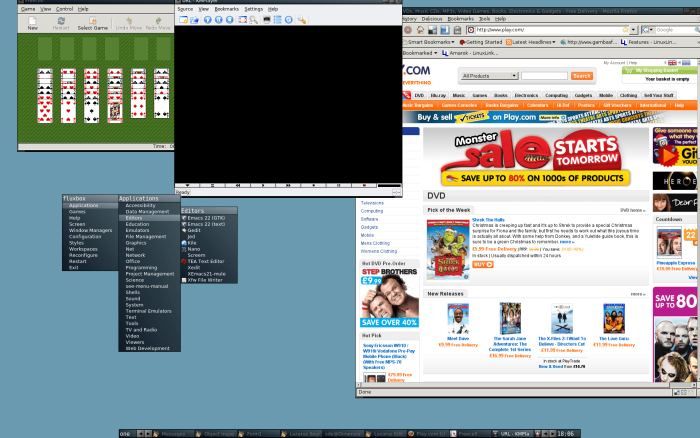Fluxbox is a lightweight window manager that was based on the Blackbox 0.61.1 code. It is very light on resources and easy to handle but yet full of features to make an easy, and extremely fast, desktop experience.
The software has been extended with features such as pwm-style window tabs, configurable key bindings, toolbar, and an iconbar. It also includes some cosmetic fixes over Blackbox.
Fluxbox provides configurable window decorations, a root menu to launch applications and a toolbar that shows the current workspace name, a set of application names and the current time. There is also a workspace menu to add or remove workspaces. The `slit’ can be used to dock small applications; e.g. most of the bbtools can use the slit.
Fluxbox can iconify windows to the toolbar, in addition to adding the window to the Icons submenu of the workspace menu. One click and they reappear. A double-click on the titlebar of the window will shade it; i.e. the window will disappear, and only the titlebar will remain visible.
Fluxbox uses its own graphics class to render its images on the fly. By using style files, users can configure exactly how the desktop looks. fluxbox styles are compatible with those of Blackbox 0.65 or earlier versions, so users migrating can still use their current favourite themes.
Fluxbox supports the majority of the Extended Window Manager Hints (EWMH) specification, as well as numerous other Window Hinting standards. This allows all compliant window managers to provide a common interface to standard features used by applications and desktop utilities.
This package contains support for GNOME and KDE.
Features include:
- Tabs – Group windows together, similar to Firefox Tabbed browsing, which makes working with a lot of windows at the same time easier.
- Virtual desktops.
- Autogrouping.
- Slit – a dock for any application that is ‘dockable’.
- Fully customizable root menu.
- Toolbar:
- Workspace Name.
- Iconbar.
- System Tray.
- Clock.
- Workspace Arrows.
- Window Arrows.
- Hot-key support.
- System tray, similar to the KDE or Windows system tray.
- Keys-file.
- Pixmap themes.
- Wallpaper chooser.
Website: fluxbox.org
Support:
Developer: Henrik Kinnunen, Simon Bowden, Mathias Gumz, Mark Tiefenbruck, Tomas Janousek
License: MIT License

Fluxbox is written in C++. Learn C++ with our recommended free books and free tutorials.
Return to Stacking Window Managers | Return to Window Managers
| Popular series | |
|---|---|
| The largest compilation of the best free and open source software in the universe. Each article is supplied with a legendary ratings chart helping you to make informed decisions. | |
| Hundreds of in-depth reviews offering our unbiased and expert opinion on software. We offer helpful and impartial information. | |
| The Big List of Active Linux Distros is a large compilation of actively developed Linux distributions. | |
| Replace proprietary software with open source alternatives: Google, Microsoft, Apple, Adobe, IBM, Autodesk, Oracle, Atlassian, Corel, Cisco, Intuit, SAS, Progress, Salesforce, and Citrix | |
| Awesome Free Linux Games Tools showcases a series of tools that making gaming on Linux a more pleasurable experience. This is a new series. | |
| Machine Learning explores practical applications of machine learning and deep learning from a Linux perspective. We've written reviews of more than 40 self-hosted apps. All are free and open source. | |
| New to Linux? Read our Linux for Starters series. We start right at the basics and teach you everything you need to know to get started with Linux. | |
| Alternatives to popular CLI tools showcases essential tools that are modern replacements for core Linux utilities. | |
| Essential Linux system tools focuses on small, indispensable utilities, useful for system administrators as well as regular users. | |
| Linux utilities to maximise your productivity. Small, indispensable tools, useful for anyone running a Linux machine. | |
| Surveys popular streaming services from a Linux perspective: Amazon Music Unlimited, Myuzi, Spotify, Deezer, Tidal. | |
| Saving Money with Linux looks at how you can reduce your energy bills running Linux. | |
| Home computers became commonplace in the 1980s. Emulate home computers including the Commodore 64, Amiga, Atari ST, ZX81, Amstrad CPC, and ZX Spectrum. | |
| Now and Then examines how promising open source software fared over the years. It can be a bumpy ride. | |
| Linux at Home looks at a range of home activities where Linux can play its part, making the most of our time at home, keeping active and engaged. | |
| Linux Candy reveals the lighter side of Linux. Have some fun and escape from the daily drudgery. | |
| Getting Started with Docker helps you master Docker, a set of platform as a service products that delivers software in packages called containers. | |
| Best Free Android Apps. We showcase free Android apps that are definitely worth downloading. There's a strict eligibility criteria for inclusion in this series. | |
| These best free books accelerate your learning of every programming language. Learn a new language today! | |
| These free tutorials offer the perfect tonic to our free programming books series. | |
| Linux Around The World showcases usergroups that are relevant to Linux enthusiasts. Great ways to meet up with fellow enthusiasts. | |
| Stars and Stripes is an occasional series looking at the impact of Linux in the USA. | |
